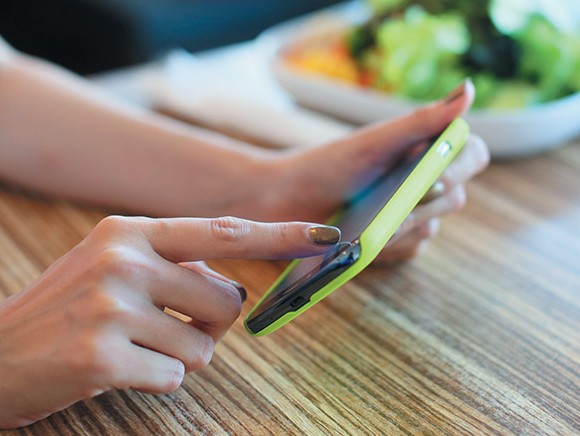
Imagine: upon entering the company canteen with your Google colleagues, your smartphone automatically guides you to the counter serving the products that are the healthiest for you personally that day. During a conference in the Netherlands at the end of 2015, Michiel Bakker, Director of Global Food Services at Google, told a room full of ‘food innovators’ that he envisages that becoming reality in the future.
It is only possible if employees register information about their current state of health and if Google knows which nutritional choices will contribute to better health for them. The vision of Dutchman Bakker, who is responsible for the food and drink products served to the US internet company’s 53,000-plus employees, is seamlessly aligned with today’s consumer trends. Consumers regard health as increasingly important and there is mounting evidence that the ‘healthiest choice’ varies from one person to another. A recent study by the Weizmann Institute of Science in Israel, published in Cell, confirmed that yet again. Research into the glucose levels of 800 people demonstrated that different people respond to the same foodstuff in different ways.
Not only do a lot of consumers now believe in personalised nutrition, but so too do many nutritional scientists. The growing use of new consumer technologies for getting and/or staying healthy demonstrates that consumers want to know and understand how their diet, or more generally their lifestyle, contributes to their health goals. Up until now, the focus has primarily been on losing weight and getting enough exercise but usage is becoming broader. Thanks to mobile internet, information is widely available and can be shared everywhere. Apps enable you to register data about what you eat, and social media encourages the sharing of knowledge and experiences. Health tools allow consumers to monitor themselves in terms of how well they sleep, how many calories they burn, their blood pressure and how stressed they are. They can express their state of health in exact figures: ‘the quantified self’.
One example is the Eetmeter (‘Food Monitor’) software from the Netherlands Nutrition Centre Foundation (Voedingscentrum) which enables you to check whether your diet is in line with nutritional guidelines. More and more people are using the program. The Eetmeter has reached 1.2 million downloads and has 700,000 active users (people who have logged in twice or more from their account). Anyone who eats too much salt or lacks vitamins, for instance, receives an automatic alert. In response to popular demand the Netherlands Nutrition Centre Foundation has also introduced the Beweegmeter (Movement Monitor) which enables you to register your daily physical activity and hence how many calories you burn. The Eetmeter is just one of the programs available for keeping track of what and how much you eat.
Dutch supermarket chain Albert Heijn also understands that more and more consumers are looking for their own healthy options and is keen to make its health-related advice more personal. According to a spokesperson, the retailer provides online nutritional advice via its AH Community, has in-store diet coaches and is investigating whether it is possible to provide personalised health-related advice based on the data from its AH Bonus loyalty-card programme. When he was CEO of AH, Sander van der Laan previously stated: “In the future, if you need to reduce your salt intake, an app will inform you what you should and shouldn’t choose off our shelves.”
‘This is an excellent chance for the industry to add new value’
We’ve not quite reached that stage yet but it won’t be long now, believes Nard Clabbers, Nutritional Scientist at TNO. He is involved in the Personalised Nutrition and Health project, supported by the Dutch Top Sector Agri&Food, within which TNO is collaborating with Wageningen University and the private sector. Clabbers envisages an improvement cycle relating to healthy nutritional choices. It starts with the consumption of the products that are aligned with consumers’ needs and lifestyles. That entails consumers recording what they eat and using health tools and apps to gain an overview of their physical condition and well-being. That data is processed and combined with other relevant data to obtain new scientific insights (big data and modelling). In the next step, consumers choose how and when they wish to receive science-based advice about their diet and lifestyle. In the Google example, for instance, that could be when they go for lunch in the company canteen. Based on the advice received in the chosen format, consumers can then decide whether to make lifestyle changes. In the next step of the cycle, consumers purchase the food that meets their needs – which may also be latent needs that were only identified after monitoring and advice. “We want to achieve a situation in which people want to – and can – make healthy choices. 2% of people currently adhere to the nutritional guidelines. What we want to know is, how can you persuade people to follow the guidelines more effectively,” says Clabbers.
The project combines food science with behavioural science because a behavioural change is often necessary in order to eat more healthily. In his model, health is not an intangible long-term concept. Instead, consumers themselves are the judge of whether they feel better when eating or excluding specific products and whether their physical state improves with one foodstuff rather than another. The feedback is rapid which provides motivation to continue with a certain lifestyle, and consumers see the benefits of their efforts. Nutrition and health are also a key focus point in terms of the need to tackle the rising costs of healthcare. “There is a long period of signs and symptoms alerting to the growing risk of diabetes before someone actually develops the full-blown condition. Intensive support can inhibit the development of the disease in some cases, but that requires a lifestyle change.”
Manufacturers and supermarkets have been responding to the growing interest in health for some time but now need to shift their focus to personalised food. “Innovation in this area offers opportunities and I believe that manufacturers and retailers should particularly look at developing new services. The existing products offer a sufficient basis for a healthy diet. An average supermarket stocks 30,000 different products so it makes sense to advise shoppers which products represent healthy choices for them at that point in time. There will also be opportunities to develop product lines for specific target groups.” In addition he sees the use of the food printer as “a logical combination with personalised food. You know what you need.”
The Federation of the Dutch Food Industry (Federatie Nederlandse Levensmiddelen Industrie/FNLI) believes that personalised food and health is still in the early stages and far from relevant for manufacturers. However, Dirk Mulder, Sector Manager Food & Retail at ING, disagrees. He collaborated on a recent report by the bank, called Food een gezonde toekomst (‘Food: A healthy future’). He regards personalised food and health as “an excellent chance for the industry to add new value to a chain in which the focus is on price, in which supply remains too high and in which, above all, consumer trust is still low. If the industry stimulates the provision of personalised nutritional advice it will shift the focus onto health instead of price alone, plus the industry will demonstrate its concern for consumer health. On average consumers are becoming older and better educated and are increasingly prepared to spend more on products and concepts that keep them healthier for longer.”

The Personal Nutrition and Health project has an ambitious goal: a society in which each individual can and will choose to eat healthily. This will require a number of questions to be answered, including with respect to data privacy. “You can use the data you’ve collected yourself, but that could perhaps also be supplemented with data held by your GP or from other medical assessments, for example. And then it’s a matter of to whom do you entrust your data so that it can be utilised? A lot of arrangements still need to be made in that area.” His project will get underway in April once the partners have all signed off on the project plan.
Source: ©Bplanet/Shutterstock.com - ©Chanpipat/Shutterstock.com